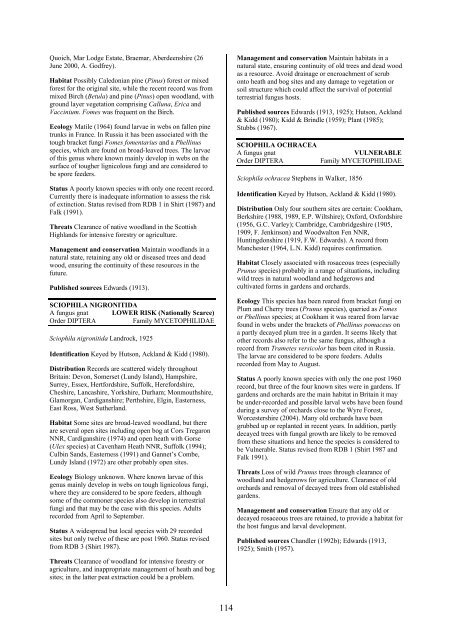Part 2: Nematocera and Aschiza not dealt with by Falk (1991) - JNCC
Part 2: Nematocera and Aschiza not dealt with by Falk (1991) - JNCC
Part 2: Nematocera and Aschiza not dealt with by Falk (1991) - JNCC
You also want an ePaper? Increase the reach of your titles
YUMPU automatically turns print PDFs into web optimized ePapers that Google loves.
Quoich, Mar Lodge Estate, Braemar, Aberdeenshire (26<br />
June 2000, A. Godfrey).<br />
Habitat Possibly Caledonian pine (Pinus) forest or mixed<br />
forest for the original site, while the recent record was from<br />
mixed Birch (Betula) <strong>and</strong> pine (Pinus) open woodl<strong>and</strong>, <strong>with</strong><br />
ground layer vegetation comprising Calluna, Erica <strong>and</strong><br />
Vaccinium. Fomes was frequent on the Birch.<br />
Ecology Matile (1964) found larvae in webs on fallen pine<br />
trunks in France. In Russia it has been associated <strong>with</strong> the<br />
tough bracket fungi Fomes fomentarius <strong>and</strong> a Phellinus<br />
species, which are found on broad-leaved trees. The larvae<br />
of this genus where known mainly develop in webs on the<br />
surface of tougher lignicolous fungi <strong>and</strong> are considered to<br />
be spore feeders.<br />
Status A poorly known species <strong>with</strong> only one recent record.<br />
Currently there is inadequate information to assess the risk<br />
of extinction. Status revised from RDB 1 in Shirt (1987) <strong>and</strong><br />
<strong>Falk</strong> (<strong>1991</strong>).<br />
Threats Clearance of native woodl<strong>and</strong> in the Scottish<br />
Highl<strong>and</strong>s for intensive forestry or agriculture.<br />
Management <strong>and</strong> conservation Maintain woodl<strong>and</strong>s in a<br />
natural state, retaining any old or diseased trees <strong>and</strong> dead<br />
wood, ensuring the continuity of these resources in the<br />
future.<br />
Published sources Edwards (1913).<br />
SCIOPHILA NIGRONITIDA<br />
A fungus gnat LOWER RISK (Nationally Scarce)<br />
Order DIPTERA<br />
Family MYCETOPHILIDAE<br />
Sciophila nigronitida L<strong>and</strong>rock, 1925<br />
Identification Keyed <strong>by</strong> Hutson, Ackl<strong>and</strong> & Kidd (1980).<br />
Distribution Records are scattered widely throughout<br />
Britain: Devon, Somerset (Lundy Isl<strong>and</strong>), Hampshire,<br />
Surrey, Essex, Hertfordshire, Suffolk, Herefordshire,<br />
Cheshire, Lancashire, Yorkshire, Durham; Monmouthshire,<br />
Glamorgan, Cardiganshire; Perthshire, Elgin, Easterness,<br />
East Ross, West Sutherl<strong>and</strong>.<br />
Habitat Some sites are broad-leaved woodl<strong>and</strong>, but there<br />
are several open sites including open bog at Cors Tregaron<br />
NNR, Cardiganshire (1974) <strong>and</strong> open heath <strong>with</strong> Gorse<br />
(Ulex species) at Cavenham Heath NNR, Suffolk (1994);<br />
Culbin S<strong>and</strong>s, Easterness (<strong>1991</strong>) <strong>and</strong> Gannet’s Combe,<br />
Lundy Isl<strong>and</strong> (1972) are other probably open sites.<br />
Ecology Biology unknown. Where known larvae of this<br />
genus mainly develop in webs on tough lignicolous fungi,<br />
where they are considered to be spore feeders, although<br />
some of the commoner species also develop in terrestrial<br />
fungi <strong>and</strong> that may be the case <strong>with</strong> this species. Adults<br />
recorded from April to September.<br />
Status A widespread but local species <strong>with</strong> 29 recorded<br />
sites but only twelve of these are post 1960. Status revised<br />
from RDB 3 (Shirt 1987).<br />
Threats Clearance of woodl<strong>and</strong> for intensive forestry or<br />
agriculture, <strong>and</strong> inappropriate management of heath <strong>and</strong> bog<br />
sites; in the latter peat extraction could be a problem.<br />
Management <strong>and</strong> conservation Maintain habitats in a<br />
natural state, ensuring continuity of old trees <strong>and</strong> dead wood<br />
as a resource. Avoid drainage or encroachment of scrub<br />
onto heath <strong>and</strong> bog sites <strong>and</strong> any damage to vegetation or<br />
soil structure which could affect the survival of potential<br />
terrestrial fungus hosts.<br />
Published sources Edwards (1913, 1925); Hutson, Ackl<strong>and</strong><br />
& Kidd (1980); Kidd & Brindle (1959); Plant (1985);<br />
Stubbs (1967).<br />
SCIOPHILA OCHRACEA<br />
A fungus gnat<br />
VULNERABLE<br />
Order DIPTERA<br />
Family MYCETOPHILIDAE<br />
Sciophila ochracea Stephens in Walker, 1856<br />
Identification Keyed <strong>by</strong> Hutson, Ackl<strong>and</strong> & Kidd (1980).<br />
Distribution Only four southern sites are certain: Cookham,<br />
Berkshire (1988, 1989, E.P. Wiltshire); Oxford, Oxfordshire<br />
(1956, G.C. Varley); Cambridge, Cambridgeshire (1905,<br />
1909, F. Jenkinson) <strong>and</strong> Woodwalton Fen NNR,<br />
Huntingdonshire (1919, F.W. Edwards). A record from<br />
Manchester (1964, L.N. Kidd) requires confirmation.<br />
Habitat Closely associated <strong>with</strong> rosaceous trees (especially<br />
Prunus species) probably in a range of situations, including<br />
wild trees in natural woodl<strong>and</strong> <strong>and</strong> hedgerows <strong>and</strong><br />
cultivated forms in gardens <strong>and</strong> orchards.<br />
Ecology This species has been reared from bracket fungi on<br />
Plum <strong>and</strong> Cherry trees (Prunus species), queried as Fomes<br />
or Phellinus species; at Cookham it was reared from larvae<br />
found in webs under the brackets of Phellinus pomaceus on<br />
a partly decayed plum tree in a garden. It seems likely that<br />
other records also refer to the same fungus, although a<br />
record from Trametes versicolor has been cited in Russia.<br />
The larvae are considered to be spore feeders. Adults<br />
recorded from May to August.<br />
Status A poorly known species <strong>with</strong> only the one post 1960<br />
record, but three of the four known sites were in gardens. If<br />
gardens <strong>and</strong> orchards are the main habitat in Britain it may<br />
be under-recorded <strong>and</strong> possible larval webs have been found<br />
during a survey of orchards close to the Wyre Forest,<br />
Worcestershire (2004). Many old orchards have been<br />
grubbed up or replanted in recent years. In addition, partly<br />
decayed trees <strong>with</strong> fungal growth are likely to be removed<br />
from these situations <strong>and</strong> hence the species is considered to<br />
be Vulnerable. Status revised from RDB 1 (Shirt 1987 <strong>and</strong><br />
<strong>Falk</strong> <strong>1991</strong>).<br />
Threats Loss of wild Prunus trees through clearance of<br />
woodl<strong>and</strong> <strong>and</strong> hedgerows for agriculture. Clearance of old<br />
orchards <strong>and</strong> removal of decayed trees from old established<br />
gardens.<br />
Management <strong>and</strong> conservation Ensure that any old or<br />
decayed rosaceous trees are retained, to provide a habitat for<br />
the host fungus <strong>and</strong> larval development.<br />
Published sources Ch<strong>and</strong>ler (1992b); Edwards (1913,<br />
1925); Smith (1957).<br />
114
















